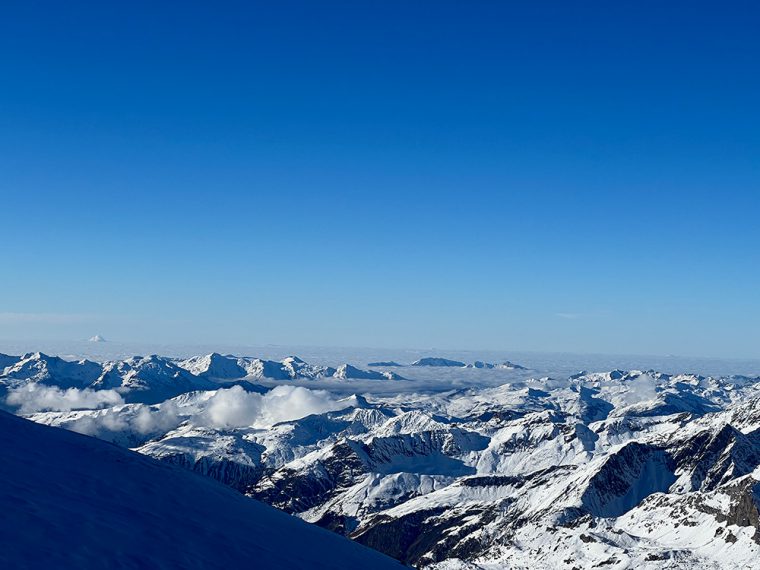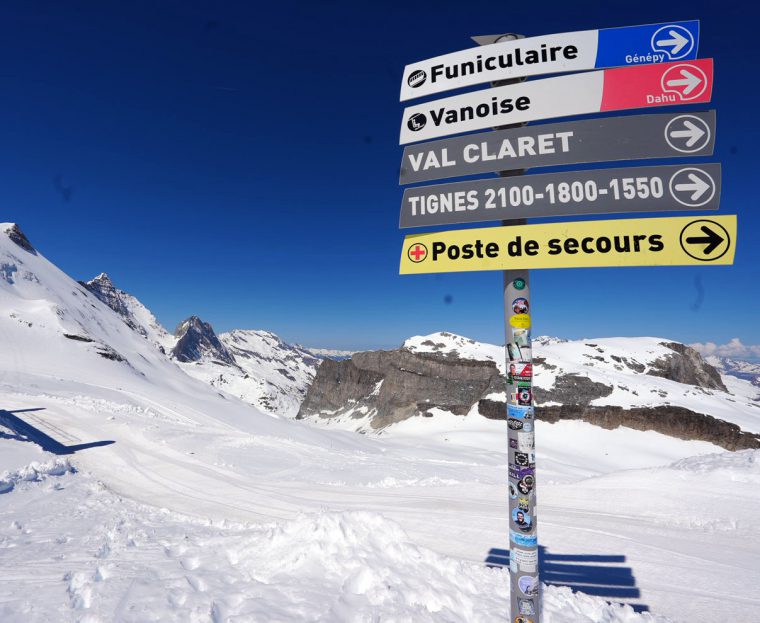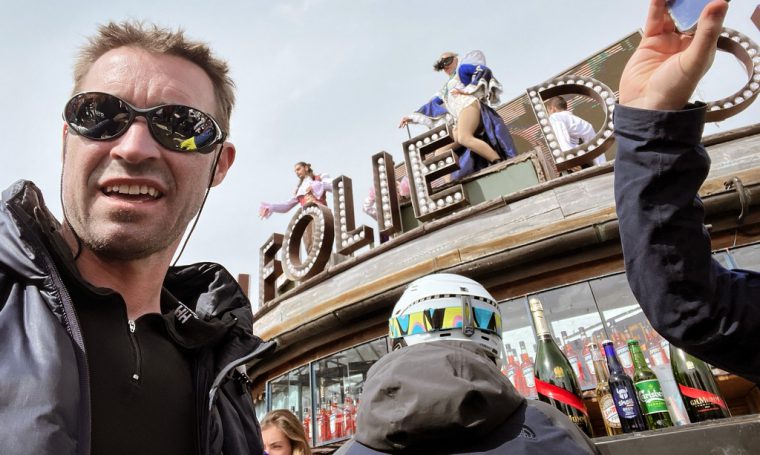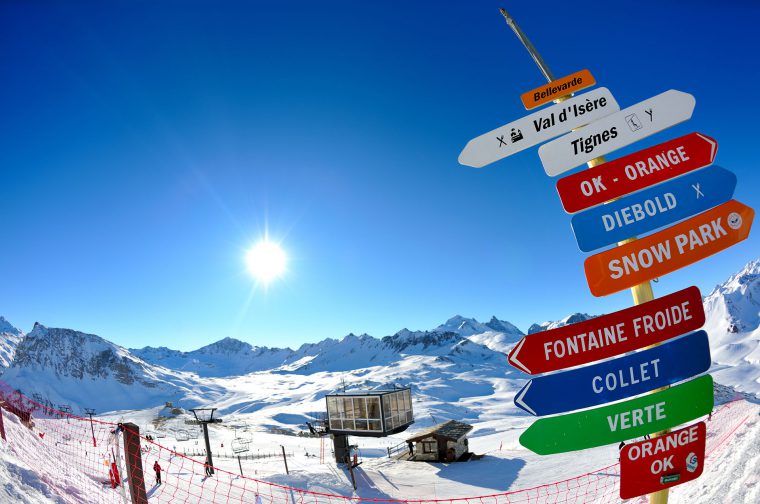Ultimate Advanced & Expert Skiers Guide to Tignes
Why Tignes is an Expert’s Playground
Tignes is a place to test yourself in big mountains. With 29 black runs across the Espace Killy (including one of Europe’s longest) and couloirs where heart rate matches altitude, Tignes demands respect but delivers reward in equal measure.
La Sache drops 1,200m over 10 glorious kilometres, Les Tufs couloirs hit gradients up to 53 degrees, and the glacier tops out at 3,456m. But Tignes is more than stats. At the top of Mickey’s Ears after a 30-minute walk in, look down a 48-degree couloir and you’ll know what I mean.

I think ‘accessibility’ sets Tignes apart, because you don’t need dawn starts and multi-hour approaches. It’s so fun to ski epic descents using the lift system. The Naturide runs are basically controlled but ungroomed blacks, easing you into off-piste.
Rich-T from SNO sums it up, “I was a good skier when I came to Tignes, but I’m getting better here.”
World-class mountain guides who know every hidden couloir, and a local scene where Guerlain Chicherit (four-time freeride world champion) is just another guy in the lift queue. You’ve found expert skiing nirvana.
The Black Runs That Define Tignes
Groomed Blacks – Where Legends Are Made
La Sache is a rite of passage starting at the Eye of the Needle at Aiguille Percée. This 10km monster descends through a remote valley to Les Brévières. Down 1,200m vertical you’ll encounter everything. Steep pitches test your edge control, mogul fields that destroy your thighs, and a schuss where 100kph isn’t unusual. Hit it first thing after groomers and you’ll understand why locals call it “meditation with consequences.”
Trolles, now renamed Johan Clarey after Tignes’ Olympic hero, drops 482m in 1.4km from Tovière. Johan clocked 141kph on the last stretch past the frozen lake.
Pramecou combines steepness and moguls. From Col des Vès, it’s “groomed” in the loosest sense. Running a piste basher over it just makes the moguls angry. On firm snow, it’s a technique exam. In soft conditions, it’s almost fun. Almost.
Silène offers a different challenge – remoteness. This black snake winds down a valley most skiers never see, far from lifts and crowds. Not the steepest black, but isolated. Bail out options limited, mobile phone signal non-existent. Have an equipment failure, it’s a long, lonely walk.
Naturide Runs – Controlled Chaos
Guerlain Chicherit is Tignes’ most challenging marked run – named after the local legend who redefined what’s possible on skis. The ‘Naturide’ off Col des Vès is never groomed and the moguls can get quite big.
Paquerettes is technically a black run, but skis more like a marked off-piste route.
Golf is sort of in-between on and off piste. From Merles you can follow the marked route or explore the powder bowls either side.
Campanules and Épilobe each offer technical skiing but Épilobe (off Chaudannes) only opens when conditions allow.
Val d’Isère Blacks are Worth the Journey
La Face was the 1992 Olympic downhill where Ortlieb took gold in 1:50.37. You won’t match that time, but line gives perspective on what “fast” really means.
Épaule du Charvet only opens in good conditions. Locals gather at the bottom to watch the carnage 😉
OK/World Cup run is an FIS course. Often groomed to race standards when possible – faster and icier than anything else in Tignes. Tuck the top section if you dare.
Tignes’ Off-Piste & Couloirs
Classic Off-Piste Runs
Vallon de la Sache represents everything magnificent about Tignes off-piste. It’s 3-minutes hike from Aiguille Percée’s summit. The classic line follows the valley floor, but I’ve seen locals in the three couloirs. From the ridge, they range from 35 degrees to 50+.
You can stay high and traverse out, or drop into the gorge at the bottom. Watch for the 30-meter frozen waterfall. I think it’s hard left traverse (but ask a guide) to avoid ice climbing.
Mickey’s Ears are famous but a half hour walk. From Tovière’s summit, you follow the ridge until you spot the twin rock formation. The couloir itself is a 48-degree sustained pitch that demands confidence/technique/commitment. No easing-in to this one.
Tour de Pramecou has multiple variants below Grande Motte glacier, each with different characters. Love the glacier backdrop – you’re properly out there, despite being just minutes from the lift system.
Les Tufs couloirs are Tignes’ answer to La Grave. Nine distinct lines dropping between Le Lac and Val Claret, ranging from 45 to 53 degrees. Approach down either Tovière or Paquis, but don’t let that fool you. Side-slipping the entrance won’t work here – you need to turn from the top.
Chardonnet Couloir drops 500m from Grattalu chair. Easy access with genuine challenge. Hike from the lift 20 minutes to a rocky outcrop and the couloir entrance. Pick the classic line (easier but busier) or the direct (steeper and often icy). Both end at Grand Huit chair, for easy laps.
Tignes’ More Technical Descents
La Petite Balme under the Grande Motte is forgiving enough to push your limits. The high-altitude snow stays good, but there are ‘sharks’ (barely covered rocks) in early and late season.
Vallée Perdue or the Lost Valley is a 10 minute ridge walk from the Combe Folle drag. Don’t miss the exit, or you’ve a taxi ride home from the next valley.
Les Boisses Couloirs are avalanche magnets where local knowledge is important.
Spatule on Bellevarde’s north face has the Olympic downhill start. Powder can linger days after a storm.

Tignes Extreme Terrain (Local Guide Essential)
Dome de la Sache approach alone is a 25-minute skin or bootpack from the valley floor. With exposed pitches above serious cliffs, route finding is critical. The classic line threads between cliff bands before opening into perfect powder fields.
Grande Balme to Aiguille Noire traverses into serious alpinism territory. With seracs, crevasses, and exposure, I recommend only attempting with qualified guides.
Lac du Chevril is nice in late-season, when the reservoir drops enough to expose the old bridge. Ski from the mid-Sache valley to the lake shore, then 20-minute walk across the dam, where you need a taxi or friend to drive back.
A Sector-by-Sector Guide for Expert Skiers
Grande Motte Glacier
At 3,456m, the glacier is best for consistent snow. The funicular and cable car combo gets you from Val Claret to the summit in minutes. Wind is the enemy here – when it’s blowing up top, it’s properly violent.
On the right day this is paradise. The Tour de Charvet drops north from the glacier, offering 1,000m of varied terrain ending at the Lac du Chevril.
SNO Pro tip: The first funicular is at 9am but the cable car doesn’t start until 9:15. We like to go inside to keep warm and get a hot-choc.
Aiguille Percée/Sache Valley
From Aiguille Percée’s summit at 2,750m, you can ski to Les Brévières at 1,550m by several routes.
The Sache valley offers classic off-piste with easy escapes. Push further into the side valleys and route finding becomes crucial. The nature reserve designation means you’re skiing through protected wilderness – ibex sightings, and the sense of remoteness is genuine.
The valley creates its own microclimate, sometimes holding good snow when other aspects are crusty. Conversely, wind can funnel through, creating huge accumulations and avalanche hazard.
Tovière Sector
Mickey’s Ears gets the glory, but dozens of other lines drop from this sector, many unnamed and unmarked on the map.
The Lavachet Wall below Tovière is visible from the village and it’s all easily lapped with the gondola.
Les Tufs couloirs have nine different lines. Central couloirs are “easiest” at around 45 degrees. The outer lines steepen to 50+, with the far skier’s left option touching 53 degrees. On a powder day they get busy but the quick access (10 minutes from lift to drop-in) means you can lap them repeatedly on different lines.
Col du Palet – The Quiet Challenge
Col du Palet offers equally challenging terrain with half the crowds. The Guerlain Chicherit run real gems lie off the sides of the marked runs. I like the bowls and gullies between La Grande Balme and Carline.
Avalanche Safety
Gear You Will Need
You must be confident in usig your transceiver, probe, and shovel. An ABS rucksack can’t guarantee you survive an avalanche, but I believe they do give you a fighting chance.
Getting More Educated
Henry’s avalanche talks are usually every week in the ski season. These aren’t basic “snow is dangerous” lectures – Henry dives deep into snow science, local conditions, and decision-making. I’ve been skiing for 40 years and learn something new each time.
Top Ski runs avalanche training on Monday evenings at 5:30pm where they teach transceiver searches, probe techniques and snow assessment.
I would recommend the ANENA course (Association Nationale pour l’Étude de la Neige et des Avalanches). They’re not cheap, but neither is a helicopter evacuation.
Learn To Do Risk Assessments
Checking the daily bulletin is important and in Tignes, pay attention to wind effect. The high altitude and exposed terrain mean wind transport is constant.
Guide Services and Expert Ski Lessons in Tignes
Recommended Mountain Guide Companies
The Bureau des Guides de Tignes represents the official guide collective, and there are lots of independent IFMGA guides in Tignes too. The bureau has a wide range of services starting with one-day off-piste guiding and prices start at €400 per day for a group of 6.
The guides at Snocool specialise in off-piste and steep skiing. Their couloir workshops teach how to assess and safely approach more extreme terrain.
Expert Progression Programs
Steep skiing clinics run throughout the season. The jump turn workshops teach how to ski over 50 degree slopes, where normal turns aren’t possible.
The touring intro courses can help you go from lift-served off-piste to true backcountry skiing. Learning efficient skinning technique and transition skills opens up terrain the lifts can’t reach.
Ice climbing combination courses reflect Tignes’ winter climbing opportunities. The frozen waterfalls around Les Brévières offer world-class ice climbing. Combining this with skiing creates the ultimate alpine experience – skin up, climb a frozen waterfall, then ski down (with a guide only!).
Notable Local Guides
I recommend Evo 2 but the biggest cadre of mountain guides in Tignes can be booked through Bureau de Guides de Tignes. The groups are more social and economical, but you’re limited by the weakest member. Private guiding lets you tailor the day exactly to your abilities and conditions. For pushing personal limits, private is worth the investment.

Snow Conditions & When to Visit Tignes
Seasonal Considerations
November and December in Tignes means glacier focus. Lower elevations need more base before the off-piste opens properly. But the glacier? It’s already in mid-season form. This is when locals lap the Tour de Charvet and other glacier routes while tourists wonder why the lower slopes are so firm.
January through February brings the deepest snowpacks and most stable conditions for steep skiing. Yes, it’s cold – properly cold. Minus 20°C at the glacier isn’t unusual. But cold snow is stable snow, and stability matters when you’re dropping into 50-degree couloirs.
March introduces the corn cycle when you should time your skiing carefully. Again, take advice from local guides.
In April and May most tourists have gone, but spring skiing is so great for experts. The snowpack is quite stable and sometimes you can get to skiing that’s too dangerous mid-winter. The Haute Route is more famous, but local tours linking Tignes with neighbouring valleys are equally stunning and have less crowds.
Where Should You Go at Different Times of Day?
North faces in mid-winter stay cold all day. Hit them anytime after avalanche control and before 3pm when flat light often moves in. These are your banker slopes – consistently good when other aspects are variable.
East faces catch first sun, going through the melt-freeze cycle earliest. In spring you can find morning corn there first but in winter they get sun crusts by noon.
South faces in winter might only soften for a two-hour window. But in spring they might be great from 11am-2pm before it’s dangerously warm. Watch them carefully – when you see the first naturally triggered wet slides, it’s time to move to northern aspects.
West faces offer afternoon perfection. While everyone’s heading home, these slopes are just coming into condition (at 4pm when the lifts are empty).
Equipment for Expert Terrain
What’s the Best Ski Selection?
If you’re still on 88mm all-mountain skis, you’re handicapping yourself. Modern powder skis in the 100-115mm range have revolutionized off-piste skiing. Yes, they’re less precise on firm snow, but when 80% of your skiing is off-piste, optimize for that.
Stiffness matters more than width. Soft skis fold in variable conditions and chatter at speed. You want a platform that remains stable when you’re straightlining through chunder or landing off wind lips.
Technical Gear You Might Consider
Crampons can make a sketchy bootpack into a slightly safer hike. Aluminum models work fine for most approaches, but if you’re regularly on firm snow or ice, steel crampons bite better. Make sure they fit your boots properly – finding out they don’t at the base of a couloir is sub-optimal.
Ice axes for ski mountaineering don’t need to be technical tools. I would take a simple, lightweight axe for exposed traverses and practice a self-arrest. Rope-work basics should be in every expert skier’s toolkit.
Physical & Mental Prep for Skiing Tignes
Physical Fitness Needed
Let’s be honest, expert skiing at altitude is physically hard, when a hike that’s easy at sea level becomes a sufferfest at 3,000m. There’s no point me telling you how to get fit before you go, but I will say its important that you do.
Mental Preparation and Toughness
I don’t do it but ‘visualization’ gets talked about a lot. i.e. seeing yourself making each turn, feel the snow etc, to anticipate the challenges. When you actually drop in, you’re executing a plan, not reacting to surprises.
Every decision – every single turn – involves risk assessment. Is that wind lip stable… can I stop before that drop… etc?
You should establish who makes route decisions? How do you communicate in terrain where voice doesn’t carry? What are your bail-out signals?
Technical Skills Needed in Tignes
Some of the tech skills are a bit obvious – e.g. jump-turns in 50-degree terrain are essential. Slough-management separates good steep skiers from hospital patients.
Recovery & Cross-Training During Your Holiday
Physical Recovery
Your body takes a beating skiing at this level. Professional massage isn’t indulgence – it’s maintenance. The sports massage therapists in Tignes understand skiing-specific issues.
There aren’t any Ice baths that I know of, but the Lagon sports centre has a cold plunge pool.
Skiers’ Yoga addresses everything that skiing pounds – hip flexors, IT bands, lower back. The mindfulness aspect helps with the mental side too. Several Tignes hotels offer ski-specific yoga sessions. Ask the SNO team and we can book your Tignes holiday in accommodation with yoga or masseur.
The Best Ski Holidays for Experts Visiting Tignes
Tignes Chalets, Hotels and Apartments nearest the Slopes
The team at SNO love this place and we have the biggest selection of Tignes accommodation, so call us for advice on 020 7770 6888 or read more about vacations skiing in Tignes.



